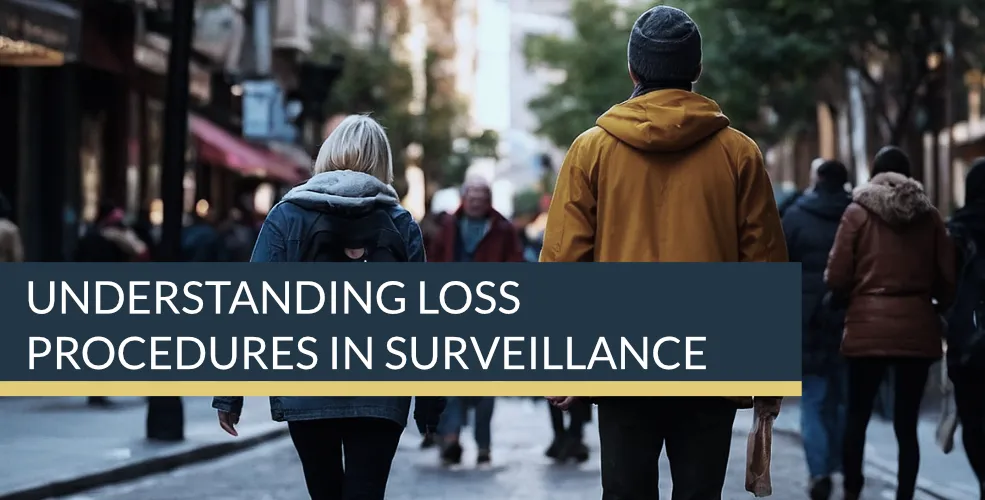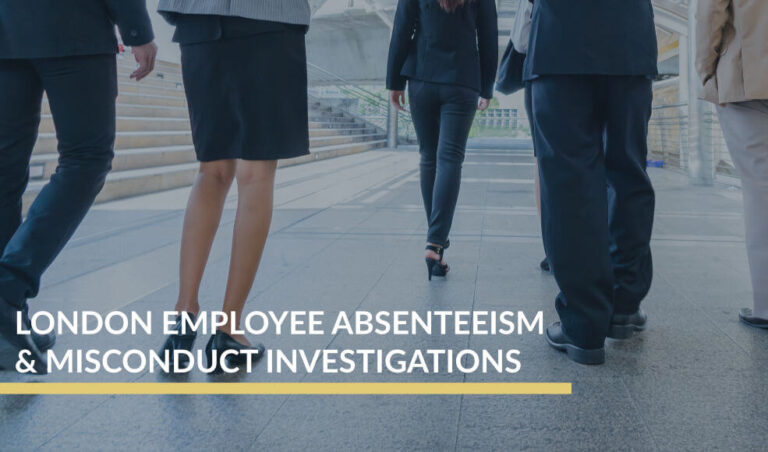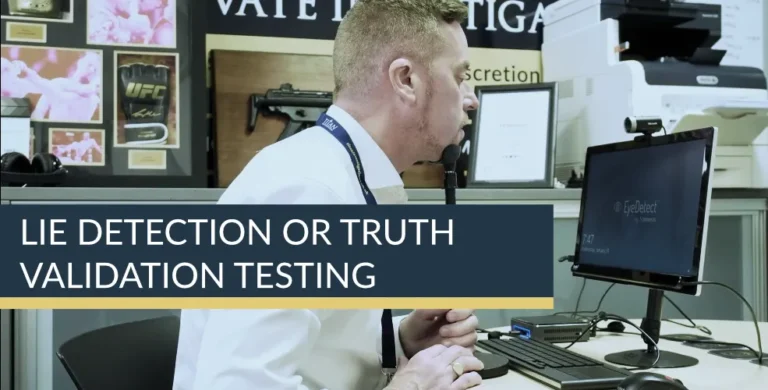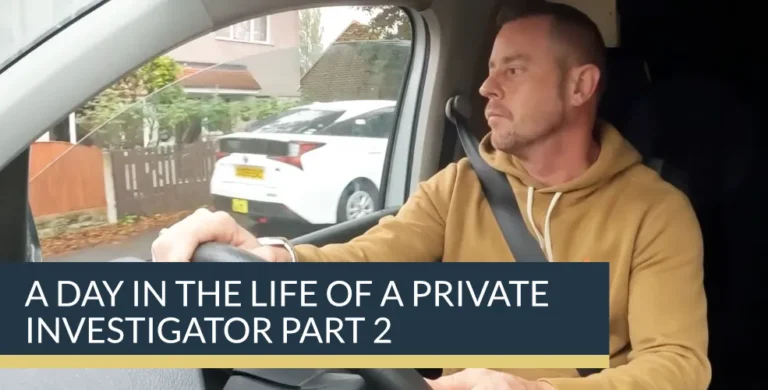Understanding Loss Procedures in Surveillance
Dealing with Losses on foot surveillance
Surveillance, as part of private investigation, requires not only meticulous attention to detail but also the ability to adapt to unforeseen circumstances. A common challenge faced by surveillance operatives is the loss of visual contact with the subject. Whether brief or permanent, the handling of such situations can greatly influence the success or failure of the operation. Understanding lost procedures in surveillance, and the methods used to recover from these situations, is critical for maintaining operational continuity and ensuring that the subject’s actions are recorded as intended.
This blog post explores in greater detail the concepts of temporary and total loss during surveillance operations, emphasising the importance of effective communication, accurate reporting, and quick recovery techniques. Through practical examples and in-depth analysis, we will provide actionable insights for operatives working in the field.
Types of Loss in Surveillance
Loss of contact during surveillance can typically be classified into two broad categories: temporary loss and total loss. Each presents its own challenges and requires different responses to mitigate the risk of losing the subject entirely.
Temporary Loss
Temporary loss occurs when an operative momentarily loses sight of the subject. This can happen for a variety of reasons, such as when the subject moves behind an obstruction, turns a corner, or merges into a crowd. In most cases, the loss is brief, and the subject can be re-acquired by the operative after a short interval.
The key in managing temporary loss is rapid and effective communication. As soon as the operative realises that the subject is out of sight, they must immediately inform the rest of the team. Communication at this stage is not just about stating that contact has been lost, but it also involves providing detailed information about the subject’s last known location and any potential clues that might help the team to regain visual contact quickly. This could include details such as the direction the subject was heading, their speed, and any distinguishing features or actions observed before the loss.
In this context, technology can play a significant role. GPS tracking, real-time mapping applications, and even drone surveillance can assist in locating the subject once again. However, the primary factor remains the operator’s ability to remain calm, focused, and communicative in high-pressure situations.
Total Loss
A total loss is a more critical scenario where the operative can no longer track the subject at all. Unlike temporary loss, total loss implies that the subject has deviated significantly from the expected route, or that a substantial obstacle has completely obstructed the operative’s view. Common causes of total loss include complex environments such as shopping centres, multiple exits from a building, or unexpected changes in transportation.
When a total loss occurs, the chances of regaining contact diminish the longer it takes to react. In these cases, it is imperative that the operative promptly reports the total loss to the team, providing as much detail as possible. An immediate and organised response from the team can increase the chances of locating the subject again.
Depending on the nature of the surveillance operation, the team might employ different tactics. This can include splitting up to cover more ground, utilising multiple vehicles in vehicular surveillance, or even deploying additional resources such as stationary operatives positioned in strategic locations. Each member of the team plays a crucial role in the recovery process, and the quality of the communication during these critical moments can make all the difference.

Early and Accurate Communication
The foundation of any successful surveillance operation lies in effective communication. Whether the surveillance team is working on foot or in vehicles, the operatives must communicate regularly, clearly, and accurately. In the context of a lost visual, early communication allows the team to respond quickly, while clear instructions and location details ensure that everyone is aligned in their efforts.
Honesty and Early Identification
One of the common mistakes made by inexperienced operatives is the hesitation to report a loss. Some may believe that they can regain sight of the subject on their own, while others may feel that reporting a loss reflects poorly on their abilities. However, in the fast-paced world of surveillance, any delay in reporting can be costly. Surveillance operatives must operate with complete honesty, acknowledging a loss as soon as it occurs. This transparency enables the team to react swiftly and reduces the risk of losing the subject for extended periods.
Structured Reporting
Once a loss has occurred, the operative must follow a structured reporting procedure. This includes stating whether the loss is temporary or total, providing precise location details, and describing any factors that might assist the rest of the team in locating the subject. The last known position of the subject is of particular importance, as it will often serve as the focal point for the search efforts.
In some cases, where the subject has moved into a complex environment, the operative may need to provide additional details such as potential escape routes, public transport hubs nearby, or any suspicious behaviour that could indicate the subject’s intentions.
Location-Specific Details
Location plays a vital role in the surveillance team’s ability to respond to a loss. While vague information such as “the subject is lost around the corner” is of little use, providing specific information such as street names, landmarks, or points of interest can drastically improve the effectiveness of the team’s recovery efforts. In some cases, operators may even rely on detailed maps or local knowledge to reposition themselves in a more advantageous location.
Procedure After Loss
Once a loss has been reported, the surveillance team must follow a predefined search procedure. This is a step-by-step approach that guides the team through the process of regaining contact with the subject. The procedure is typically tailored to the specifics of the operation but will generally involve the following steps:
- Report the Loss: Immediately notify the team of the loss and provide all relevant information.
- Reposition the Team: Depending on the subject’s last known location, the team should split up to cover potential escape routes and nearby areas.
- Conduct a Visual Sweep: Team members should search the surrounding area, paying attention to high-traffic locations, potential transportation options, and any exit routes the subject may have taken.
- Use Technology if Available: In some cases, the use of GPS trackers, public CCTV, or other surveillance technologies may assist in locating the subject.
- Review the Subject’s Pattern of Behaviour: Analysing the subject’s previous actions and movements may provide clues as to where they might be heading next.
Practical Examples of Loss Management
To further illustrate these concepts, let’s revisit the earlier scenarios involving a female subject and her daughter.
Scenario 1: Temporary Loss
In the first example, the operative momentarily loses sight of the subjects as they approach a busy intersection. By immediately reporting the temporary loss and providing the last known location, the operative ensures that the rest of the team is aware of the situation. After a brief search, the subjects are located once again, and the surveillance continues without major disruption. This scenario highlights the importance of prompt communication and maintaining situational awareness.
Scenario 2: Total Loss
In the second example, the subjects disappear after rounding a corner, and the operative loses them entirely. Recognising this as a total loss, the operative quickly informs the team and suggests a coordinated search of nearby shops and streets. Thanks to the swift reporting and the team’s organised response, the subjects are eventually relocated. This case underscores the importance of teamwork and a structured response in managing total loss situations.
Conclusion
Managing losses during surveillance is a key skill for any private investigator. By understanding the differences between temporary and total loss, and by employing a structured approach to communication and search procedures, surveillance teams can maximise their chances of successfully regaining contact with their subjects. The mastery of these techniques not only enhances the overall success rate of surveillance missions but also ensures that the client receives the most accurate and comprehensive results.
As surveillance technology continues to evolve, operatives can expect new tools to aid in loss recovery. However, the principles of clear communication, teamwork, and strategic thinking will always remain central to effective surveillance operations. Whether you are a seasoned investigator or just beginning your career in private investigation, understanding these lost procedures will serve as an invaluable asset in your professional toolkit.
Dealing with subject losses find out more
For further advice and information about Surveillance techniques and Titan’s surveillance training courses, then please feel free to speak to one of our professional team at one of the offices nearest to you.
London Surveillance Training – Call the Titan Investigations London Office 020 39046622
Birmingham Surveillance Training – Call the Titan Investigations Birmingham Office 0121 7162442
Cambridge Surveillance Training – Call the Titan Investigations Cambridge Office 01223 662022
Derby Surveillance Training – Call the Titan Investigations Derby (Head Office) 01332 504256
Leeds Surveillance Training – Call the Titan Investigations Leeds Office 0113 4574066
Leicester Surveillance Training – Call the Titan Investigations Leicester Office 0116 2436520
Nottingham Surveillance Training – Call the Titan Investigations Nottingham Office 0115 9646950
Manchester Surveillance Training – Call the Titan Investigations Office 0161 3023008
Sheffield Surveillance Training – Call the Titan Investigations Sheffield Office 0114 3499400
Truro Surveillance Training – Call the Titan Investigations Truro Office 01872 888706
Alternatively, you can contact us directly using our fully confidential contact form at enquiries@titaninvestigations.co.uk or chat directly using our Live Chat facility and one of our surveillance training course team will get right back to you.















